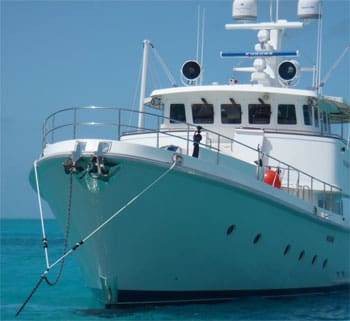When I started working in the trawler business 14 years ago I didn’t realize how many of the basic concepts I learned growing up racing sailboats would transfer over from sail to power. Sure an appreciation for wind, tide, currents and general nautical variables are universal, but as I have trained my trawler clients out at sea I’ve been reminded time and again that one of my old racing fundamentals, the mind set of “tracking and repeatability” (observing, recording and writing down what is working best), actually makes sense on powerboats too.
Racing sailors will inscribe lay line tacking angles on their decks, put permanent ink marks on lines at ideal settings for reference and apply other tricks to help keep their boat settings tuned and make it easier to keep track of optimum adjustments to maximize speed. When you are rounding a leeward mark in the middle of a race it pays to quickly return to the setup (repeat) that was working on your last upwind beat so you don’t have to start from scratch when trimming your sails. Creating references and developing the ability to quickly duplicate what is most efficient saves time and improves results. Sailboat racers are in tune with their surroundings…they operate outside in the breeze, are one with the elements and get a feel for what is right by the seat of their pants and the wind on their skin.
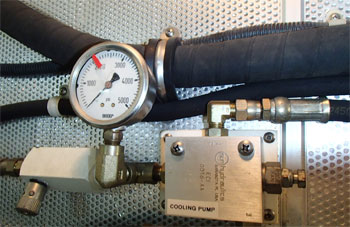 |
|
Analog gauge marks — visual inspection at a glance — to show normal needle settings when equipment is warmed up and working properly. |
Trawler owners don’t race their powerboats and don’t set out to be the fastest. Trawler helmsmen are also typically more isolated from the environment in a protected pilothouse. There are many key components you really should pay attention to, however. So over the years I’ve developed a room-by-room system of good ideas and tips to help owners “dial-in” their trawlers — this is mostly based on familiarization — tracking and monitoring systems and equipment. Here are some beginning concepts you can try on any trawler:
Performance chart
The essential operating system on your trawler is your engine (engines if you have twins). You need to know how your boat will perform at various RPM settings — so I like to spend an hour or two running reciprocal courses out on the water (to average the effects of wind and sea). This lets me develop a performance chart that shows what speeds the trawler is traveling in knots, and I can usually calculate fuel burn and range (distance that particular boat will achieve at a given RPM). Most modern Tier II engines also show a percent load readout to show how hard the engine is pushing. On a full displacement trawler it’s nice to know, for example, that your wide open throttle at 2,200 RPM will push you along at 8.5 knots (guzzling 10 gallons an hour) and that you can back off to 1,600 RPM, travel a knot slower at 7.5 knots and reduce fuel consumption to sip three gallons an hour. Developing this performance chart for your boat is a key first step for planning to travel at sea.
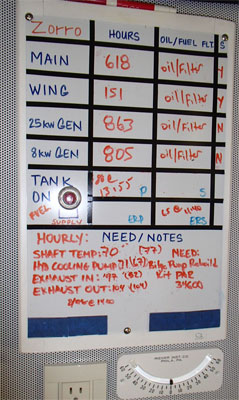 |
|
Dry erase boards are a simple way to keep track of engine room maintenance. |
The higher the RPM the hotter your engine(s) will run, so you have to keep an eye on coolant temperature and oil pressure. For those of you with analog gauge instruments, it’s pretty easy to cut a small triangle of red tape and have it point to the “normal” readings for oil pressure and coolant temperature once you have established them. These “at-a-glance” indicators let you know if all is well. You can use this same technique on any analog pressure gauge like the air pressure on your steering or your hydraulic system gauges for your active fin stabilizers.
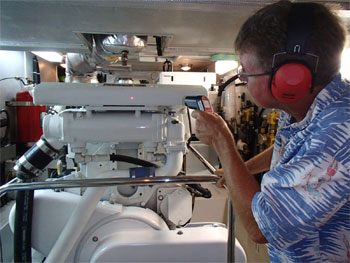 |
|
The author doing an engine room check with infrared thermometer gun (note ear muffs for sound protection). |
Engine room temperature checklist
It is also important to develop an engine room temperature checklist spreadsheet. To conduct a safe check you should don safety goggles, ear muffs and knee pads, bringing an infrared thermometer (IRT) gun and a clip board to record your inspection. I like to take a bright pen and make a small circle on the surface of the machinery parts I want to log details for and then record the temperatures I get from the IRT gun (always shooting the same spot and at a close range no greater than six inches away) on the spreadsheet to keep track of trends and see what the normal operating values are. The engine room temperature checklist should also include visual items to track like belt chafe, oil and fuel drips under the engine, needle gauge on fire suppression, engine mounts slipping, bilge level, etc. I recommend doing an engine room check walk-through every hour on the hour until you really know your boat, then you can relax and do one every three or four hours as you change watch. Break down your list by area in a logical progression from bow to stern covering port and starboard. I also recommend a dry erase board as an easy way to keep records and remember maintenance projects.
Little details throughout
In addition to monitoring your performance and machinery, there are all kinds of small things you can do to get your trawler “dialed-in” and ready for sea. Use a label maker to identify replacement intervals of filters and write up simple operation instructions on laminated cards. Visual reminders are the most effective.
Do you have your anchor chain color coded at key lengths so you know what you have paid out? Are you using seizing wire on your anchor shackles and a snubber line to secure the anchor and take the load off the windlass when you drop the hook? If you are using a crane, you can apply electrical tape to mark the correct position of the rotating base parts and angle of the boom arm so that when they are aligned you know you are in the correct position to pick up or retrieve your tender.
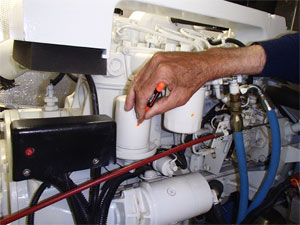 |
|
Mark items with a permanent marker for temperature measurement so you can be sure to “shoot” the same spot each time. |
In the living spaces, the galley can be pretty lively at sea so I like to make sure that the refrigerator goodies are in plastic tubs (so that things don’t fly around in rough seas when you open the door) and I also recommend using compression bars to “fence off” the shelves and keep items from bouncing down on the galley sole.
Instructions by the heads of what can and can NOT be flushed might spare you a messy and smelly afternoon if an unwitting guest inadvertently clogs a toilet.
Use your boat
The best thing you can do to “dial-in” your trawler is use your boat and become aware of the subtle tell-tales that are sprinkled around providing clues for operation. Start locally and anchor out, if you are missing something you can add it to your inventory before your next outing. Travel to the nearest sea port and keep a list of little things you learn to continually update and improve your understanding. As you become more comfortable and familiar with your boat, you will become in tune with all of the many moving parts and quickly know if anything has changed. Use your senses to establish baseline norms and then monitor and record your observations as you continually “dial-in” your trawler and become more aware of the many moving parts that you can track and repeat.
————-
Jeff Merrill, CPYB, is a yacht broker with Nordhavn Yachts. Merrill is active in the marine industry as a public speaker and writer. You can learn more by attending his seminar, “Dialing-In Your Trawler” at the Baltimore, Md., Trawler Fest on Saturday, Sept. 28, 2013. Merrill enjoys time at sea with clients sharing his experience and is constantly looking for new ideas to improve and simplify the trawler lifestyle. If you have a suggestion or want to get in touch: trawlerspecialist@gmail.com.

